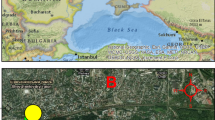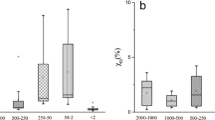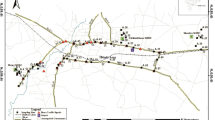Abstract
The assessment of anthropogenic impact in the urban environment can be evaluated according to heavy metal contents of soils such as Pb, Cu, Zn, Cd and Fe. These elements have more affinity to establish metallic bond with ferrous material leading to enhancement of soil magnetic susceptibility. The objective of this study was to undertake joint magnetic and geochemical investigations of road-side urban soil materials to address the environmental pollution of Beni Mellal city that has been subjected to environmental stress, due to population overpressure and related urbanization. Twenty three soils magnetic susceptibility profiles were made along 5 km peripheral national road (N8) in Beni Mellal. The magnetic survey reported here for the first time on this City’s topsoils tries to establish the link between magnetic properties and the content of heavy metals. High magnetic susceptibility values and high contents of heavy metals were found near the paved edge of the road and within the place reserved as large engine park. Magnetic extracts of highly polluted areas and unpolluted soil (olive plantation) were analyzed by SEM coupled with RDX in order to discriminate anthropogenic magnetic spherules and pedo-lithogenic magnetite-like minerals. Magnetic mineralogy determined by Mössbauer spectroscopy suggests the presence of hematite, magnetite and goethite in highly polluted areas. The iron oxides and especially goethite are efficient in incorporating and/or adsorbing foreign ions.












Similar content being viewed by others
References
Allen SE, Grimshaw HM, Rowland AP (1986) Chemical analysis. In: Moore PD, Chapman SB (eds) Methods in plant ecology. Blackwell, Oxford, pp 285–344
Andersson M, Ottesen RT, Langedal M (2010) Geochemistry of urban surface soils—monitoring in Trondheim, Norway. Geoderma 156:112–118
Barrero CA, Vandenberghe RE, De Grave E, da Costa MG (1996) A qualitative analysis of the Mössbauer spectra of aluminous goethites based on existing models. In: Ortalli I (ed) Proceedings of the international conference on the applications of the Mössbauer eVect (ICAME-95), Italian Physical Society, Italy, pp 717–720
Berquó TS, Imbernon RAL, Blot A, Franco DR, Toledo MCM, Partiti CSM (2007) Low temperature magnetism and Mössbauer spectroscopy study from natural goethite. Phys Chem Mineral 34:287–294
Bijaksana S, Huliselan EK (2010) Magnetic properties and heavy metal content of sanitary leachate sludge in two landfill sites near Bandung, Indonesia. Environ Earth Sci 60:409–419
Boyko T, Scholger R, Stanjek H, Team M (2004) Topsoil magnetic susceptibility mapping as a tool for pollution monitoring: repeatability of in situ measurements. J Appl Geophys 55:249–259
Brand RA (1987) NORMOS program, Internat Rep Angewandte Phys. Universität Duisberg, Duisberg
Chan LS, Ng SL, Davis AM, Yim WWS, Yeung CH (2001) Magnetic properties and heavy-metal contents of contaminated seabed sediments of Penny’s Bay, Hong Kong. Mar Pollut Bull 42:569–583
Chaparro MAE, Sinito AM, Ramasamy V, Marinelli C, Chaparro MAE, Mullainathan S, Murugesan S (2008) Magnetic measurements and pollutants of sediments from Cauvery and Palaru River, India. Environ Geol 56:425–437
Chaparro MAE, Gogorza CSG, Chaparro MAE, Irurzun MA, Sinito AM (2006) Review of magnetism and heavy metal pollution studies of various environments in Argentina. Earth Planets Space 58(10):1411–1422
Dearing JA (1999) Environmental magnetic susceptibility, using the Bartington MS2 System, 2nd edn. Chi Publishing, England
Duan XM, Hu SY, Yan HT, Blaha U, Roesler W, Appel E, Sun WH (2009) Relationship between magnetic parameters and heavy element contents of arable soil around a steel company, Nanjing. Sc. China Earth Sc. doi: 10.1007/s11430-009-0165-1
Durza O (1999) Heavy metals contamination and magnetic susceptibility in soils around metallurgical plant. Phys Chem Earth 24:541–543
El Baghdadi M, Barakat A, Agouriane E, Sajieddine M (2010) Soil magnetic susceptibility as a proxy to detect urban pollution in Beni Mellal City (Morocco). In: 10ème Conférence Internationale en Physique de la Matière Condensée et Physique Statistique, Beni Mellal, 25–26 Mars 2010, p 92
Fassbinder JWE, Stanjek H (1994) Magnetic properties of biogenic soil greigite (Fe3S4). Geophys Res Lett 21:2349–2352
Gautam P, Blaha U, Appel E (2005a) Integration of magnetism and heavy metal chemistry of soils to quantify the environmental pollution in Kathmandu, Nepal. Island Arc 14:424–435
Gautam P, Blaha U, Appel E (2005b) Magnetic susceptibility of dust-loaded leaves as a proxy of traffic-relatedheavy metal pollution in Kathmandu city, Nepal. Atmos Environ 39:2201–2211
Gautam P, Blaha U, Appel E, Neupane G (2004) Environmental magnetic approach towards the quantification of pollution in Kathmandu urban area, Nepal. Phys Chem Earth 29:973–984
Gunther A, Brokmeier HG, Petrovsky E, Siemes H, Helming K, Quade H (2002) Mineral preferred orientation and magnetic properties as indicators of varying strain conditions in naturally deformed iron ore. Appl Physics A 74:S1080–S1082. doi:10.1007/s003390101194
Hanesch M, Scholger R (2005) The influence of soil type on the magnetic susceptibility measured throughout profiles. Geophys J Int 161:50–56
Hanesch M, Scholger R (2002) Mapping of heavy metal loadings in soils by means of magnetic susceptibility measurements. Env Geol 42:857–870
Hay KL, Dearing JA, Baban SMJ, Loveland P (1997) A preliminary attempt to identify atmospherically derived pollution particles in English topsoils from magnetic susceptibility measurements. Phys Chem Earth 22:207–210
Heller F, Strzyszca Z, Magiera T (1998) Magnetic record of industrial pollution in forest soils of Upper Silesia. Poland J Geophys Res 103:17767–17774
Hoffmann V, Knab M, Appel E (1999) Magnetic susceptibility mapping of roadside pollution. J Geochem Explor 66:313–326
Hounslow MW, Maher BA (1996) Quantitative extraction and analysis of carriers of magnetization. Geophys J Int 124:57–74
Hounslow MW, Maher BA (1999) Laboratory procedures for quantitative extraction and analysis of magnetic minerals from sediments. In: Walden J, Oldfield F, Smith JP (eds) Environmental magnetism: a practical guide. Quarternary Research Association Technical Guide No. 6, London, pp 139–189
Hu XF, Su Y, Ye R, Li XQ, Zhang GL (2007) Magnetic properties of the urban soils in Shanghai and their environmental implications. Catena 70:428–436
Hunt A, Jones J, Oldfield F (1984) Magnetic measurements and heavy metals in atmospheric particulates of anthropogenic origin. Sci Total Environ 33:129–139
Jordanova D, Jordanova N (1999) Magnetic characteristics of different soil types from Bulgaria. Stud Geophys Geod 43:303–318
Jordanova NV, Jordanova DV, Veneva L, Yorova K, Petrovsky E (2003) Magnetic response of soils and vegetation to heavy metal pollution. A case study. Environ Sci Technol 37:4417–4424
Kapicka A, Petrovsky E, Ustjak S, Machackova K (1999) Proxy mapping of fly ash pollution of soils around a coal-burning power plant: a case study in the Crech Republic. J Geochem Explor 66:291–297
Kim W, Doh SJ, Park YH, Yun ST (2007) Two-year magnetic monitoring in conjunction with geochemical and electron microscopic data of roadside dust in Seoul, Korea. Atmos Environ 41:7627–7641
Knab M, Appel E, Hoffmann V (2001) Separation of the anthropogenic portion of heavy metal contents along a highway by means of magnetic susceptibility and fuzzy c-means cluster analysis. Eur J Environ Eng Geophys 6:125–140
Lecoanet H, Leveque F, Ambrosi JP (2003) Combination of magnetic parameters: an efficient way to discriminate soil contamination sources (south France). Environ Pollut 122:229–234
Lu SG, Bai SQ (2006) Study on the correlation of magnetic properties and heavy metals content in urban soils of Hangzhou City, China. J Appl Geophys 60:1–12
Magiera T, Strzyszcz Z (2000) Ferrimagnetic minerals of anthropogenic origin in soils of some Polish National Parks. Water Air Soil Pollut 124:37–48
Maher B (1999) Comments on origin of the magnetic susceptibility signal in Chinese loess. Quat Sci Rev 18:865–869
Maher B (2007) Environmental magnetism and climate change. Contemp Phys 48:247–274
Maher B (2009) Rain and dust: magnetic records of climate and pollution. Elements 5:229–234
Maher B, Thompson R (1999) Palaeomonsoons I: the magnetic record of palaeoclimate in the terrestrial loess and palaeosol sequences. In: Maher BA, Thompson R (eds) Quaternary climates, environments and magnetism. Cambridge University Press, Cambridge, pp 81–125
Maher BA, Alekseev A, Alekseeva T (2003) Magnetic mineralogy of soils across the Russian steppe: climatic dependence of pedogenic magnetic formation. Palaeogeogr Palaeoclimatol Palaeoecol 201:321–341
Matzka J, Maher B (1999) Magnetic biomonitoring of roadside tree leaves: identification of spatial and temporal variations in vehicle-derived particulates. Atmos Environ 33:4565–4569
Morton-Bermea O, Hernandez E, Martinez-Pichardo E, Soler-Arechalde AM, Lozano Santa-Cruz R, Gonzalez-Hernandez G, Beramendi-Orosco L, Urrutia-Fucugauchi J (2009) Mexico City topsoils: Heavy metals vs. magnetic susceptibility. Geoderma 151:121–125
Murad E, Cashion J (2004) Mössbauer spectroscopy of environmental materials and their utilization. Kluwer, Boston
Muxworthy AR, Schmidbauer E, Petersen N (2002) Magnetic properties and Mössbauer spectra of urban atmospheric particulate matter: a case study from Munich, Germany. Geophys J Int 150:558–570
Pandey SK, Tripathi BD, Prajapati SK, Mishra VK, Upadhyaya AR, Rai PK, Sharma AP (2005) Magnetic properties of vehicle-derived particulates and amelioration by Ficus infectoria: a keystone species. Ambio 34(8):645–646
Petrovsky E, Ellwood BB (1999) Magnetic monitoring of air-, land- and waterpollution. In: Maher BA, Thompson R (eds) Quaternary climates, environments and magnetism. Cambridge University Press, Cambridge, pp 279–322
Petrovsky E, Kapicka A, Jordanova N, Boruvka L (2001) Magnetic properties of alluvial soils contaminated with lead, zinc and cadmium. J Appl Geophys 48:127–136
Perkins AM (1996) Observations under electron microscopy of magnetic mineraIs extracted from speleothems. Earth Planet Sci Lett 139:281–289
Schneeweiss O, Zboril R, Pizurova N, Mashlan M, Petrovsky E, Tucek J (2006) Novel solid-state synthesis of a-Fe and Fe3O4 nanoparticles embedded in a MgO matrix. Nanotechnology 17:607–616
Schwertmann U, Wagner F, Knicker H (2005) Ferrihydrite–Humic associations: magnetic hyperfine interactions. Soil Sci Soc Am J 69:1009–1015
Shu J, Dearing JA, Morse AP, Yu LZ, Yuan N (2001) Determining the sources of atmospheric particles in Shanghai, China, from magnetic and geochemical properties. Atmos Environ 35:2615–2625
Singer MJ, Verosub KL, Fine P (1996) A conceptual model for enhancement of magnetic susceptibility of soils. Quat Int 34–36:243–248
Stanjek H, Fassbinder JWE, Vali H, Wagele H, Graf W (1994) Evidence of biogenic greigite (ferrimagnetic Fe3S4) in soil. Eur J Soil Sci 445:97–104
Strzyszcz Z, Magiera T (1998) Magnetic susceptibility and heavy metals contamination in soils of southern Poland. Phys Chem Earth 23:1127–1131
Taylor R, Maher B, Self P (1987) Magnetite in soils: I. The synthesis of single-domain and superparamagnetic magnetite. Clay Minerals 22:411–422
Trivedi P, Axe L, Dyer J (2001) Adsorption of metal ions onto goethite: single-adsorbate and competitive systems. Colloids Surface A 191:7–121
Vandenberghe RE, Barrero CA, Costa GM, Van San E, De Grave E (2000) Mössbauer characterization of iron oxides and (oxy)hydroxides: the present state of the art. Hyperfine Interact 126:247–259
Wang XS, Qin Y (2006) Comparison of magnetic parameters with vehicular Br levels in urban roadside soils. Env Geol 50:787–791
Wang XS, Qin Y, Sang SX (2005) Accumulation and sources of heavy metals in urban topsoils: a case study from the city of Xuzhou, China. Env Geol 48:107
Xie S, Dearing JA, Boyle JF, Bloemendal J, Morse AP (2001) Association between magnetic properties and element concentrations o f Liverpool street dust and its implications. J Appl Geophys 48:83–92
Yang T, Liu Q, Chan L, Cao G (2007) Magnetic investigation of heavy metals contamination in urban topsoils around the East Lake, Wuhan, China. Geophys J Int 171:603–612
Zhang C, Huang B, Li Z, Liu H (2006) Magnetic properties of high-road-side pine tree leaves in Beijing and their environmental significance. Chin Sci Bull 51:3041–3052
Acknowledgements
The authors acknowledge funding for this project provided by the Centre National de la Recherche Scientifique et Technique of Morocco (UATRS service).
Author information
Authors and Affiliations
Corresponding author
Rights and permissions
About this article
Cite this article
El Baghdadi, M., Barakat, A., Sajieddine, M. et al. Heavy metal pollution and soil magnetic susceptibility in urban soil of Beni Mellal City (Morocco). Environ Earth Sci 66, 141–155 (2012). https://doi.org/10.1007/s12665-011-1215-5
Received:
Accepted:
Published:
Issue Date:
DOI: https://doi.org/10.1007/s12665-011-1215-5




